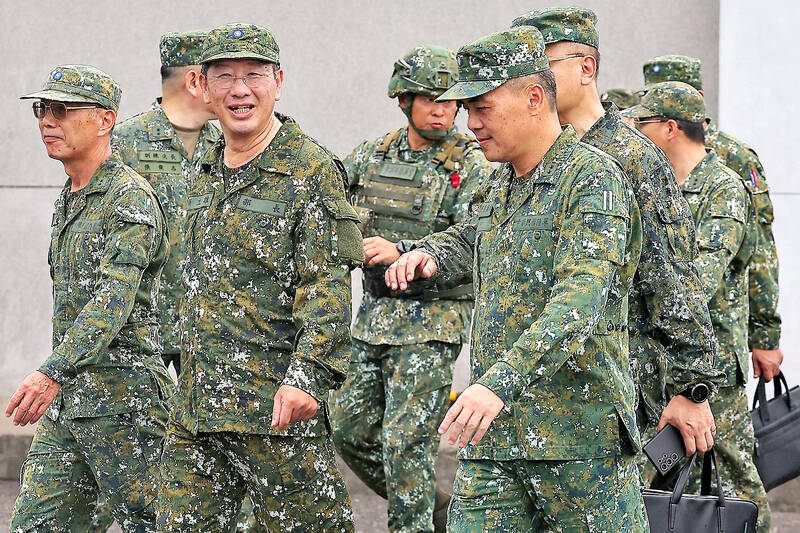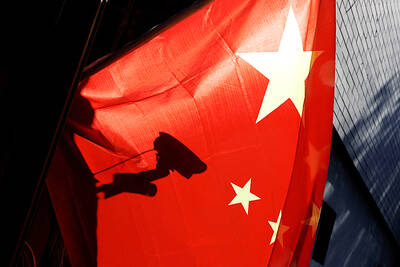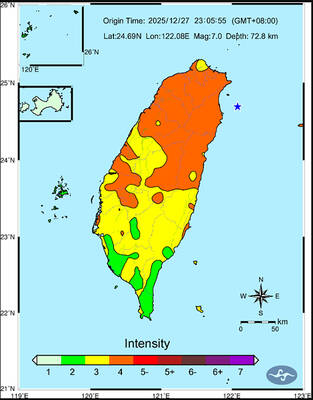Taiwan intends to focus on the research, development and implementation of drone systems, artificial intelligence (AI) and other advanced technologies to fortify the nation’s defense, Minister of National Defense Wellington Koo (顧立雄) said at a meeting with journalists on Wednesday.
As part of this initiative, Taiwan has established the Defense Innovation Team — its own version of the US’ Defense Innovation Unit — which will focus on drone development, counterdrone systems and defense applications of AI, Koo said in comments embargoed until yesterday.
This was in line with a pledge Koo made earlier this year that he would oversee a new team that would bring together the nation’s military and private companies to boost the nation’s asymmetrical warfare capabilities.

Photo: Ann Wang, Reuters
During the meeting, Koo spoke about how this year’s national defense budget reflects the importance of asymmetric warfare and the need to invest in Taiwan’s reserves.
However, traditional military hardware is still necessary to defend against China’s “gray zone” tactics, he added.
The Defense Innovation Team would evaluate submissions from the military branches and lead a cross-ministerial process that includes the National Science and Technology Council, the Ministry of Economic Affairs and the Ministry of Digital Affairs, he said.
If Taiwan lacks the necessary capabilities to implement proposals, the team would seek foreign support, having already had in-depth exchanges with its US counterpart, Koo said.
With the trend of decoupling from China, there is potential for Taiwan to produce or share production of much of the technology, he said.
Representatives from the US Department of Commerce are to visit Taiwan this month to discuss the possibility of joint production, he added.
Although the technology might not use Taiwanese branding for geopolitical reasons, Taiwan’s abilities in advanced technologies and its role in global supply chains can offer significant opportunities for dual-use goods such as drones, Koo said.
Friendly and unfriendly militaries will increasingly use drones, so the military branches would need to discuss how to effectively integrate new technologies and systems, not only in combat scenarios, but also in operational guidelines and training, Koo said.
The Army Education, Training and Doctrine Development Command has already ordered officers in charge of training to familiarize themselves with the new systems and adjust organizational structures as discussions continue and technology evolves.
China’s “gray zone” intrusions and large training exercises make it more difficult to identify when Taiwan is under threat, which means the nation’s forces might have less time to react than previously imagined, Koo said.
The minister, in rare comments about military cooperation, also said that Taiwan’s combat effectiveness has improved thanks to its deepening security partnership with the US and other friends and allies.
“In the past few years, Taiwan, the US and other friends and allies have continuously strengthened security partnerships, and continued to expand and deepen military cooperation,” he said. “This has contributed to the improvement of the national military’s combat effectiveness and regional peace and stability.”
Cooperation focuses on “substantively improving” combat effectiveness rather than just “formality,” Koo said.
“The defense ministry has never publicized this foreign military cooperation with great fanfare. This is due to taking into account the international situation and respect for our friends and allies. It is also to avoid unnecessary interference,” he added.
Koo also announced reforms to existing military training and equipment.
Close-quarters combat training would be fully implemented from next year onward, he said.
This comes after traditional bayonet drills were canceled this year following Koo’s appointment as defense minister.
Bayonet training is to remain outside of the new guidelines, he said.
The army, military police and reserves would start receiving new T112 rifles, with 86,114 units to be shipped between next year and 2028, Koo said.
Based on operational needs, the rifles are equipped with optical sights, tactical lights and lasers that help improve shooting speeds, reaction times and target acquisition, Koo said.
The Armaments Bureau is capable of meeting production targets, he said.
The bureau is also developing new ballistic plates that can withstand the Chinese military’s armor-piercing bullets, with production set to start next year.
Next year, the Armaments Bureau is to produce 25,000 T112 rifles, as well as 60,000 to 70,000 ballistic plates, bureau Deputy Director Huang Ching-pei (黃清培) said.
The bureau is also developing a new rifle which is due to be completed in March next year for testing by the military branches, Koo said.
Additional reporting by CNA and Reuters

A magnitude 7.0 earthquake struck off Yilan at 11:05pm yesterday, the Central Weather Administration (CWA) said. The epicenter was located at sea, about 32.3km east of Yilan County Hall, at a depth of 72.8km, CWA data showed There were no immediate reports of damage. The intensity of the quake, which gauges the actual effect of a seismic event, measured 4 in Yilan County area on Taiwan’s seven-tier intensity scale, the data showed. It measured 4 in other parts of eastern, northern and central Taiwan as well as Tainan, and 3 in Kaohsiung and Pingtung County, and 2 in Lienchiang and Penghu counties and 1

FOREIGN INTERFERENCE: Beijing would likely intensify public opinion warfare in next year’s local elections to prevent Lai from getting re-elected, the ‘Yomiuri Shimbun’ said Internal documents from a Chinese artificial intelligence (AI) company indicated that China has been using the technology to intervene in foreign elections, including propaganda targeting Taiwan’s local elections next year and presidential elections in 2028, a Japanese newspaper reported yesterday. The Institute of National Security of Vanderbilt University obtained nearly 400 pages of documents from GoLaxy, a company with ties to the Chinese government, and found evidence that it had apparently deployed sophisticated, AI-driven propaganda campaigns in Hong Kong and Taiwan to shape public opinion, the Yomiuri Shimbun reported. GoLaxy provides insights, situation analysis and public opinion-shaping technology by conducting network surveillance

‘POLITICAL GAME’: DPP lawmakers said the motion would not meet the legislative threshold needed, and accused the KMT and the TPP of trivializing the Constitution The Legislative Yuan yesterday approved a motion to initiate impeachment proceedings against President William Lai (賴清德), saying he had undermined Taiwan’s constitutional order and democracy. The motion was approved 61-50 by lawmakers from the main opposition Chinese Nationalist Party (KMT) and the smaller Taiwan People’s Party (TPP), who together hold a legislative majority. Under the motion, a roll call vote for impeachment would be held on May 19 next year, after various hearings are held and Lai is given the chance to defend himself. The move came after Lai on Monday last week did not promulgate an amendment passed by the legislature that

AFTERMATH: The Taipei City Government said it received 39 minor incident reports including gas leaks, water leaks and outages, and a damaged traffic signal A magnitude 7.0 earthquake struck off Taiwan’s northeastern coast late on Saturday, producing only two major aftershocks as of yesterday noon, the Central Weather Administration (CWA) said. The limited aftershocks contrast with last year’s major earthquake in Hualien County, as Saturday’s earthquake occurred at a greater depth in a subduction zone. Saturday’s earthquake struck at 11:05pm, with its hypocenter about 32.3km east of Yilan County Hall, at a depth of 72.8km. Shaking was felt in 17 administrative regions north of Tainan and in eastern Taiwan, reaching intensity level 4 on Taiwan’s seven-tier seismic scale, the CWA said. In Hualien, the